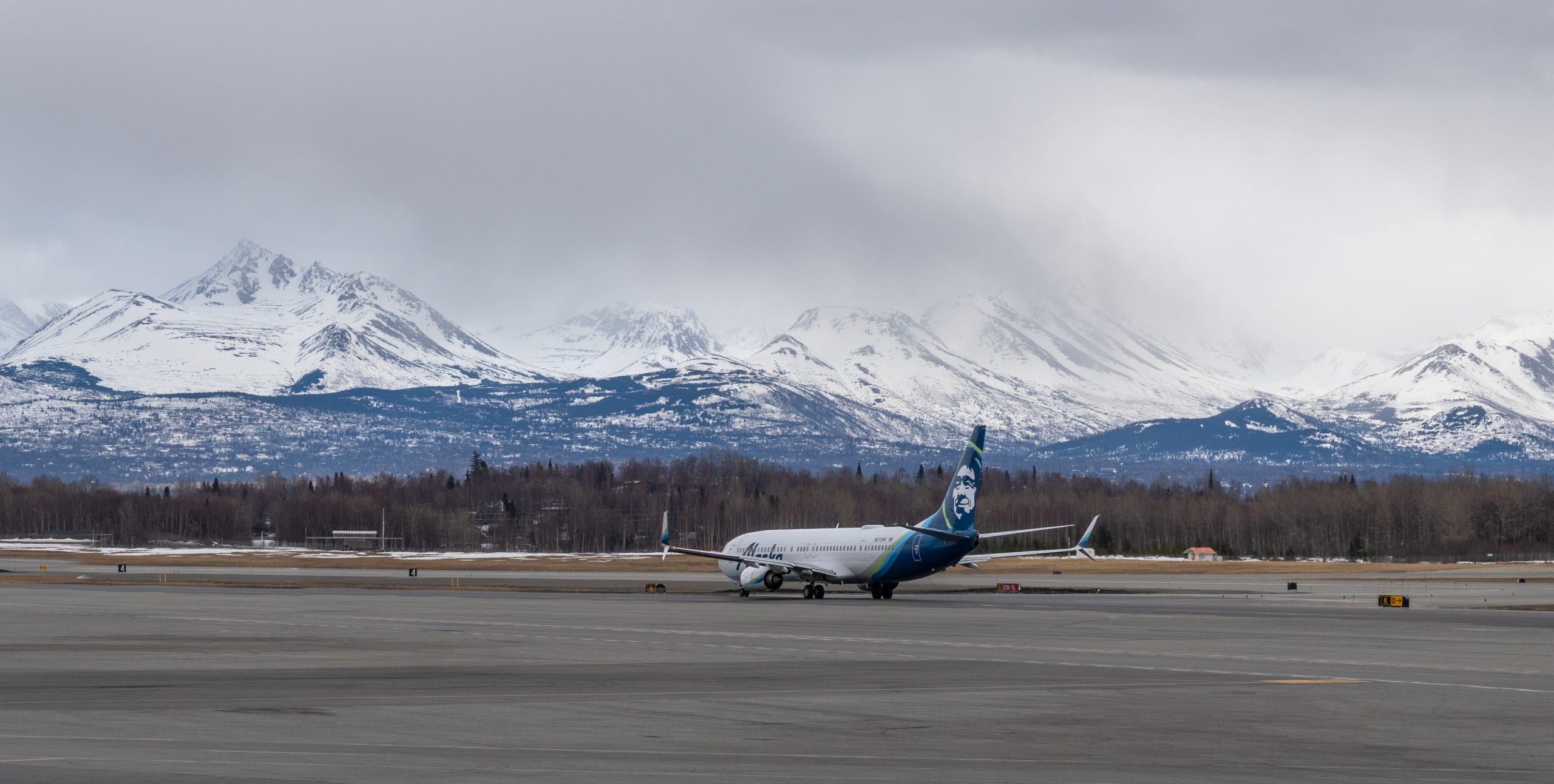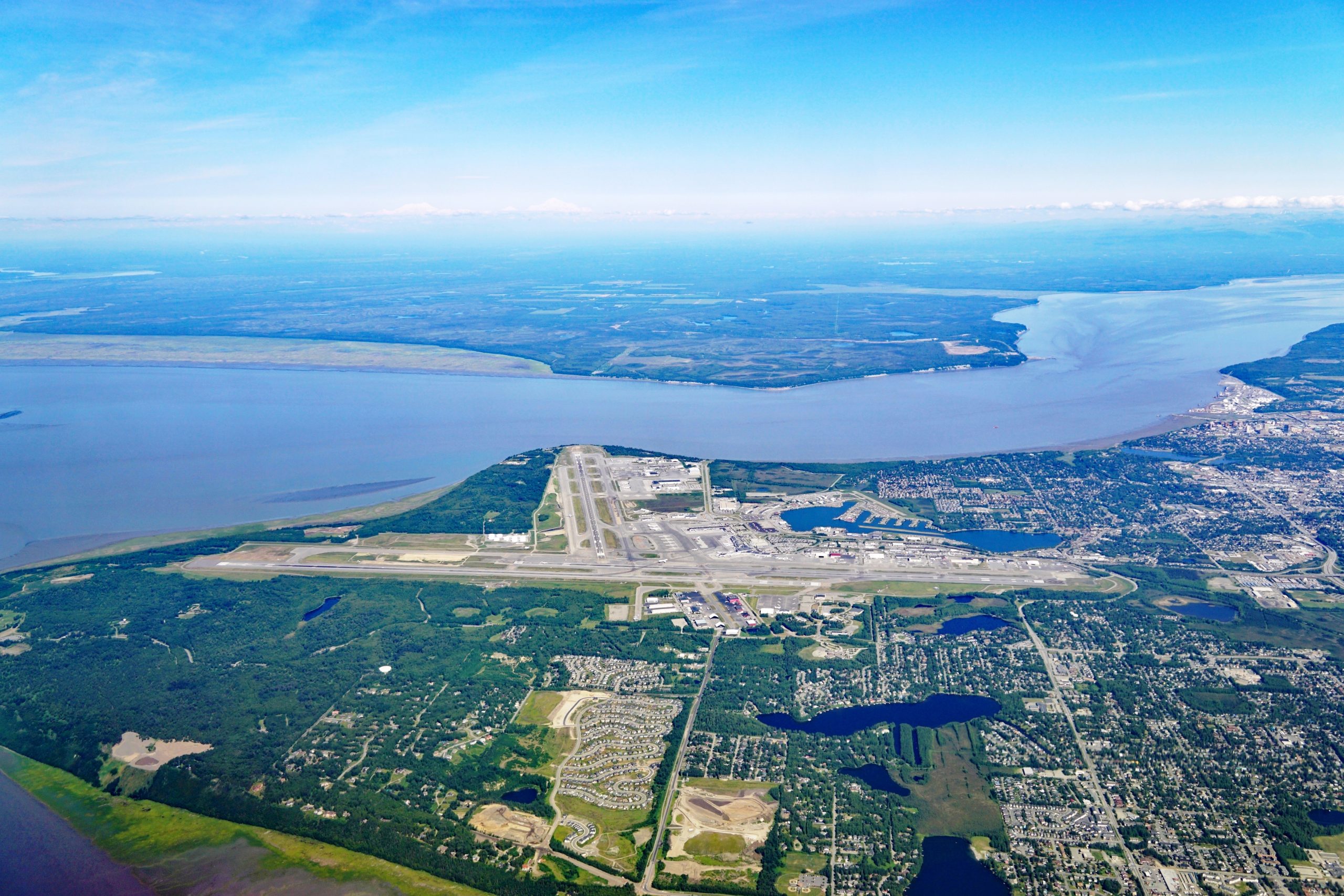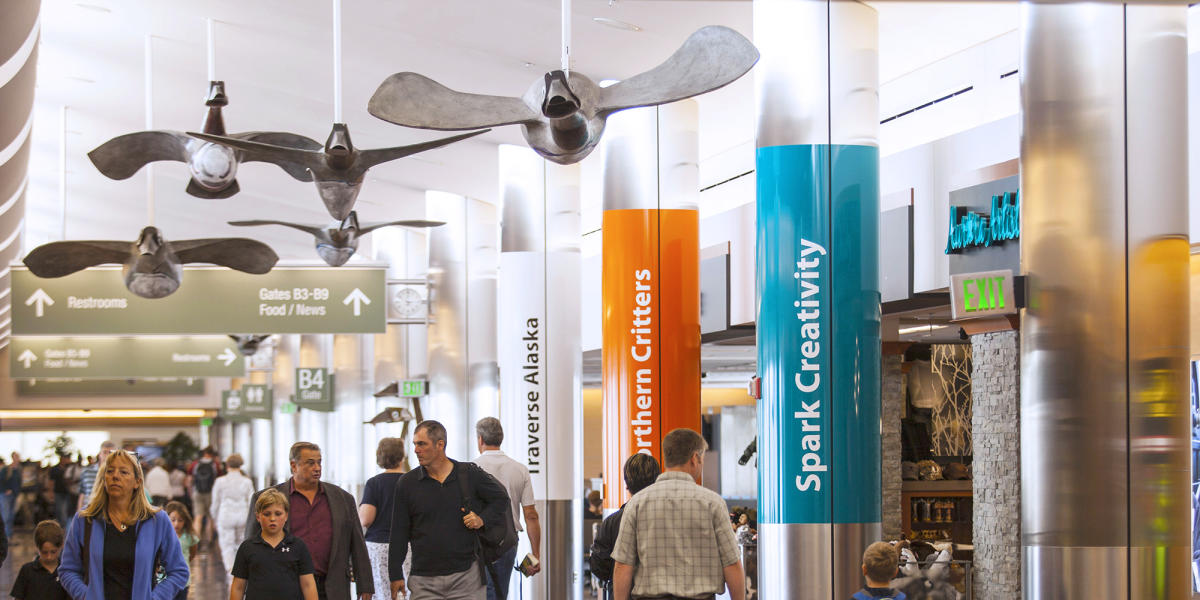In an exclusive interview, we spoke with Angie Spear, Director of the Alaska International Airport System, and Teri Lindseth, Anchorage Airport Development Manager—the driving force behind Anchorage’s transformation into a global cargo hub.
Anchorage Airport has become one of the world’s busiest cargo airports, ranking fourth globally for two consecutive years, even surpassing some of the most well-known international airports. What key strategies have driven that growth? And what’s the game plan to maintain—or even elevate—that position in the years ahead?
Angie Spear: We are very fortunate in Alaska to benefit from a significant geographic advantage.
Anchorage International Airport is a part of the Alaska International Airport System, along with Fairbanks International—so it’s a natural stop for cargo operators. They can make technical stops, refuel, and take advantage of our cargo transfer options.
We’re being very intentional about how we grow. We’re working on getting grants to help fund development, and we’re in constant contact with our engineering team. Our focus is on making sure we have top-notch facilities, plenty of apron space, and enough parking to support both the large cargo planes and the passenger aircraft that serve our region.
And we’re seeing continued growth in Alaska’s visitor industry as well. So, we have a robust passenger market that continues to grow. That means we need to meet the needs of both types of carriers (cargo and passenger – editor) —which can be quite similar in some ways, but also very different at the same time. We want to make sure we’re leveraging every possible technology so that we’re operating a state-of-the-art airport that meets the needs of all users.
Teri Lindseth: Our infrastructure investments are focused on maintaining the highest level of safety at our airport. With support from annual federal grants, we prioritize projects that reinforce this commitment. We’re always working to stay at the forefront of innovative technologies—making sure our airport remains one of the safest in the world.

What emerging trends or technologies are you most excited about when it comes to boosting efficiency, sustainability, or the overall experience at Anchorage Airport, whether for passengers or cargo? And how is ANC positioning itself to stay ahead of the curve?
A: From both a cargo and passenger perspective, we use state-of-the-art gate management software. Our operations team relies on it for both passenger and cargo flights to keep things running as efficiently as possible.
As we all know, every minute—and even every second matters, especially in aviation, where minutes equals dollars. We want to be as efficient as possible on the ground.
And we do have a challenging winter environment. We want to make sure we proactively mitigate any weather-related disruptions so that it does not impact carriers we serve.
We also have a common-use platform in place for our passenger airlines, which helps improve flexibility and efficiency at the terminal. We’re also in the early design phases of developing a common-use system for our cargo carriers. It is something we’re really excited about!
We want to lead the way – in every possible area: in passenger experience, in technology, and in cargo operations. The aviation industry is very fluid; it is constantly evolving.
And of course, as you mentioned, our airport also benefits tremendously from our strategic geographic location as a key transit point. That’s a major advantage we’re always working to maximize.
Let’s talk economics, what kind of impact does Anchorage Airport have on Alaska’s economy?
A: Anchorage is the largest airport in the state of Alaska and really serves as the heart of our incredibly robust aviation network. 82% of our state isn’t connected by a road system. So, for us—as Alaskans—aviation is a way of life.
It is the only way communities, especially remote, can access essential services and critical medical care. It’s how vital goods—from medications and groceries to building supplies—reach communities. So, when I say that aviation is life in Alaska, I mean that quite literally.
Aviation has a strong support of a local economy. With the amount of development that continues to happen at the Anchorage Airport and the growth, both in cargo and passenger, that supports jobs in the communities and in our local economy. In fact, one in every eight jobs in the Anchorage area is tied to aviation. That’s significant.
T: We are also working closely with regional airlines to expand their route networks to improve air service to rural communities. Both Anchorage and Fairbanks serve as vital hubs to support those airlines in carrying out their missions. Of course, with our strategic location come some unique challenges—especially environmental ones—but that’s part of what drives us to keep innovating.

You’ve talked about the challenges that come with your unique location—can you share any real-world examples or stories of how your team’s tackled those head-on? What lessons have come out of those moments?
A: There’s a reason why the Anchorage Airport Snow Removal Team has won the Balchen/Post Award 8 times. It’s because of the exceptional work they do managing huge volumes of snow, ice, and the wide range of weather challenges Anchorage area gets.
I truly can’t say enough about the operations and maintenance teams at both of our international airports—they’re outstanding.
And while Anchorage and Fairbanks are just a short 50-minute flight apart, weather patterns between the two are drastically different. If Anchorage is having high winds, a blizzard, and a snowstorm, Fairbanks is probably cold and very dry at the same time.
And if Fairbanks is in the middle of a storm, there’s a good chance Anchorage might be warmer. If Fairbanks has a blizzard, it might be raining, or even sunny here.
So, we support each other – for example, by handling diversionary flights for cargo or passengers.
* Diversionary flights are flights that are forced to land somewhere other than their original destination due to unexpected issues—like medical emergencies, mechanical problems, or severe weather conditions (editor).
Anchorage plays a role many people don’t even realize. We serve as a diversion point for passenger flights that are coming from many Asian cities en route to the Lower 48. If there’s a medical emergency, a mechanical issue, or any kind of unplanned situation, Anchorage is where they land.
Diversion point is an airport where a flight can land unexpectedly when it can’t continue to its original destination—usually due to emergencies like mechanical issues, medical situations on board, or severe weather (editor).
We may have two to three unplanned diversion flights a week. At the heart of it, it is about saving lives. If someone on board is having a heart attack, being able to land quickly in a city like Anchorage or Fairbanks, where life-saving medical care is available, can truly mean the difference between life and death.
These diversions do not generate significant revenue or boost our operational stats; they represent another vital role our airports play—as a critical lifeline when it matters most.
Walk me through your vision when it comes to developing Anchorage Airport in the next decade?
T: We are wrapping up our master planning — our last one was in 2014, and we aim to update it roughly every 10 years.
In the short- to mid-term, our focus is on maintaining infrastructure to continue to meet FAA standards and ensure safe, efficient operations. We have a substantial amount of pavement and acreage to maintain, which requires continuous investment — approximately 4,210 acres.
With cargo volumes expected to grow by approximately 2% annually, we’re focusing on expanding critical airport infrastructure to meet future demand. A key priority is the development of new hardstand parking to enhance our ability to accommodate cargo aircraft even more efficiently. In addition, several third-party developers are pursuing plans for new cargo facilities that will complement our efforts.
As for passenger traffic, we’re forecasting annual average passenger traffic growth rate of about 2.3% over the next 20 years.
Looking ahead over the next 20 years, we have several terminal infrastructure projects in the pipeline. That includes planned expansion of our domestic terminal and upgrades to the international terminal to ensure we continue to meet the evolving needs of the travelling public.

Do you have any sustainability initiatives in mind?
T: Yes, we’re excited to be launching our first federally funded airport sustainability project this year. We’re still early in the process—currently drafting the RFP—but we expect to have a contractor on board by the end of the year.
This project will give us a strategic roadmap to reduce Anchorage Airport’s environmental footprint, ensure compliance with evolving regulations, and strengthen our relationship with the local community. It’s a proactive step toward towards building a more sustainable future for the airport and for Alaska.
A: We also have a strong focus on sustainable aviation fuels, which has become a key priority for us. This initiative has been championed by our Department of Transportation, with incredible support and leadership from both our Commissioner and Deputy Commissioner.
We’ve been working hand in hand with the airlines to explore what options might work best for sustainable aviation fuels here in Alaska. The state is rich in natural resources, so the question becomes: which one offers the most promise? Identifying the right solution is critical—not just for our airport system, but for the global carriers we serve who are increasingly committed to decarbonizing aviation.
What’s the biggest challenge Anchorage is facing right now?
T: I’d say that every day in my role brings a new challenge—and honestly, it’s the most rewarding job I could ever ask for. There’s always a new problem to solve, and that’s what makes it so meaningful.
What makes it all possible is the incredible team I get to work alongside—whether it’s our operations crew, the airfield maintenance team, leasing teams, or our air service development folks. Whatever the challenge, I’m always confident that together, we’ll find a solution.
We have a strong, dedicated workforce, and that gives us the ability to overcome just about anything—for the good of the aviation community and for the state of Alaska.

Your near-term, mid-term, and long-term priorities?
Our short-term focus is on taking a holistic look at what we are already doing and how we can do better.
We have already conducted a deep-dive audit of all operations at both international airports. We’ve reviewed our tenants. Our leasing goal isn’t “to divide the pie into smaller pieces”, but to grow the pie—to increase revenue potential for everyone operating at the airport.
We want to be resilient, agile, current on technology, and we want to make sure that those that are part of our system are successful as well. Whether we’re talking about passengers, airlines, ground handlers, or third-party developers—our focus is on customer satisfaction and growth.
We’ve also been working hand in hand with community groups because we want to be good neighbours. We want to hear what people are telling us, we want to empathize, and we want to understand.
Our mid-term goal is to ensure that all projects (both federal- and airline-funded) come to fruition.
In addition to our sustainability initiatives, we want to make sure we have energy redundancy across our airport system so there are no vulnerabilities. If there’s ever an issue, let’s say with electric power or gas, we want to have backup options to avoid disruption. And if one of our surrounding communities is impacted, we want to be able to help lessen it. With nearly 24-hour daylight in Anchorage and Fairbanks, we’re exploring how solar energy can help us leverage this natural advantage.
Long term, it’s about preparing for growth. We’re focused on our trigger points—like expanding our TSA checkpoints, increasing gate capacity, and planning future terminal enhancements to meet rising demand.
We’re making sure we’re ready to serve today’s aircraft.
When our terminal was built, 20 to 25 years ago, the fleet was very different from what we see now. So, are we equipped to serve wide-body passenger aircraft? Are we ready for newer models? Are our jet bridges as efficient and adaptable as they can be?
And if you’re asking about my audacious goal—I’d love to see us have 150 wide-bodies per day within the next five to seven years.
*wide-body aircraft – editor
We’re already over 100 right now, and while our projections are conservatively in 2-5% growth per year, I believe hitting that 150 mark is ambitious and doable. If barring some unforeseen, global events that we have no control over, I would like to see us continue our record-setting growth that we started during the pandemic.
Angie, you have been with the airport system, primarily in Fairbanks—for 20 years now. You are also the second woman to serve as Director of the Alaska International Airport System. What’s the one piece of advice you’d offer to someone just starting out in this industry?
A: Be humble. Listen more than you speak—because that’s how you are going to learn.
I started in communications and marketing, but I spent a lot of time out on the airfield with operations. As you grow into leadership, never lose touch with what it’s like to be boots on the ground. Stay connected to your teams. Listen to them. If you want to create meaningful change, don’t do it in a vacuum. Surround yourself with the people who are actually doing the work.
Aviation is one of the best careers you can get into. And it doesn’t matter where you start—you can become the airport director. My goal is that the next person who takes on this role after me is even more dynamic, more energetic, and filled with new ideas. I have someone on staff right now who just started at the front desk—and they’ve told me they want my job someday. And you know what? Let’s give them the path to get there. There’s nothing that makes me prouder than promoting from within.
T: One of the things that’s helped me with my career growth is to find a mentor, somebody that you really look up to and admire. And then, at some point, the roles reverse—you find yourself in a position where you can start mentoring others who are eager to grow in aviation.
That’s where I am now. I’m fortunate to be in a position where I can support and guide others around me while still looking up to my own mentor, Angie.
It’s a unique and deeply rewarding place to be.






comments